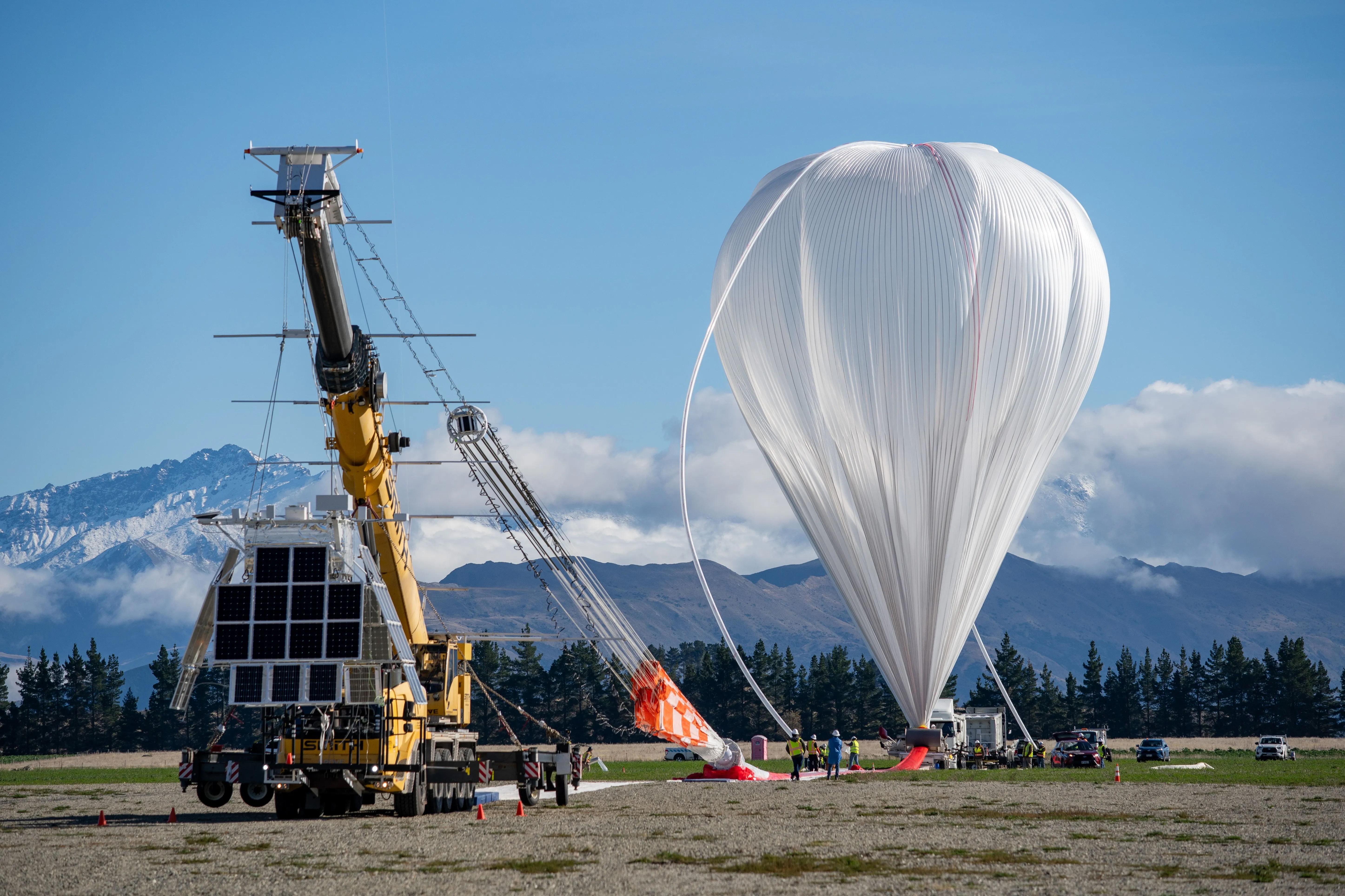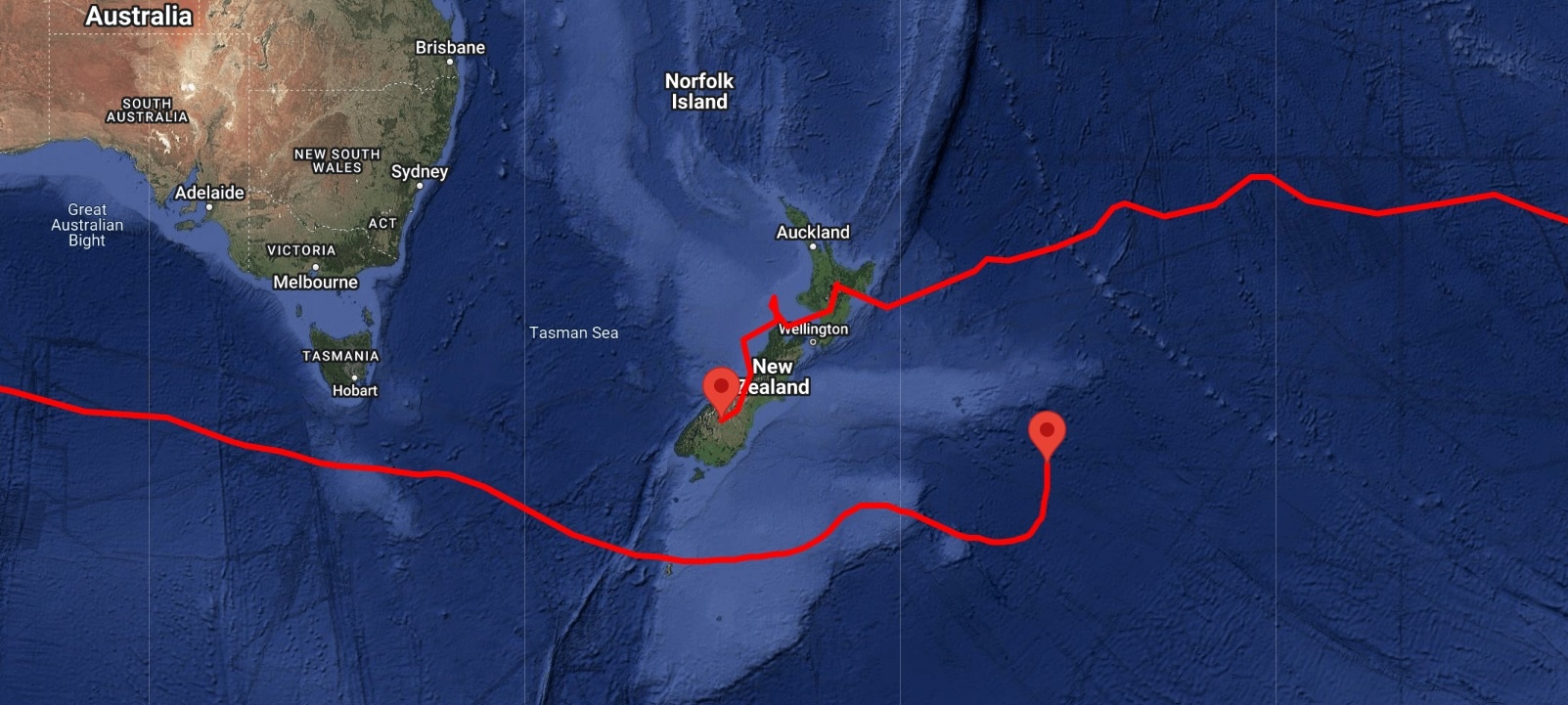5.05.2025

The second super pressure balloon flight of NASA’s New Zealand Balloon Campaign is now at float at 108,000 feet after lifting off from Wānaka Airport, New Zealand, at 11:38 a.m. NZST, Sunday, May 4 (7:38 p.m., Saturday, May 3 in U.S. Eastern Time). The football-stadium-sized, heavy-lift super pressure balloon is on a mission planned for up to 100 days about the Southern Hemisphere’s mid-latitudes to further test and qualify the super pressure balloon technology.
“The picture perfect launch and ascent into float of our second super pressure balloon caps off a highly successful New Zealand campaign,” said Gabriel Garde, chief of NASA’s Balloon Program Office at the agency’s Wallops Flight Facility in Virginia. “To have both missions aloft and nearby one another is phenomenal for such a complex mission operation. Our launch team as well as all of the crucial support both onsite and remote enabled are what made this possible and we could not be more pleased.”
The helium-filled 18.8 million-cubic-foot balloon ascended at a rate of about 1,000 feet per minute, fully inflating along the way until it reached its operational float altitude of about 110,000 feet (33.5 km) above Earth’s surface around two hours after launch. While the mission will spend most of its time over water, some land crossings will occur. If weather permits, the balloon may be visible from the ground, particularly at sunrise and sunset. NASA invites the public to track the balloon’s path in real-time here.
While the balloon flight’s primary mission is further test and qualify the agency’s super pressure balloon technology, it is also carrying several smaller science investigations and technology demonstrations.
Quelle: NASA
+++
NASA Balloon Circumnavigates World in 16 Days
More than 16 days after lifting off from Wānaka, New Zealand, NASA’s football-stadium-sized super pressure balloon has completed its first full circumnavigation of the globe — a significant milestone for the test flight around the Southern Hemisphere’s mid-latitudes. The balloon crossed the 169.24 east longitude line at 7:22 a.m. Saturday, May 3 (U.S. Eastern Time).
“I am very proud of the mission’s continued success, which is directly reflected in the excellence of our dedicated operations and engineering team,” said Gabriel Garde, chief of NASA’s Balloon Program Office at the agency’s Wallops Flight Facility in Virginia. “Both the balloon and science instruments have been functioning well during the test flight.”
While the mission has successfully met its minimum requirements for science and qualification of the balloon, the team has been monitoring minor performance issues and has verified that the system has a small leak. The balloon has been maintaining its predicted float altitude during daytime hours; however, during the latest night periods, the balloon started showing a considerable drop in altitude, especially as it passed over areas of colder temperatures like storm systems. All ballast — extra weights added to the balloon gondola — has been expended to manage altitude stability.
Teams will continue to closely monitor the health and performance of the balloon as it continues flight, and its ability to safely make it to land for recovery of the balloon and payload. The next land crossing would occur over South America in approximately five days.
“While we have experienced some issues in altitude performance, the balloon structure and its design have performed very well giving us significant confidence in the viability of the platform to support science,” said Garde. “It will still be several days before we overfly land again, and we are looking toward recovering our hardware and assessing the systems.”
The super pressure balloon is an 18.8-million-cubic-foot (532,000-cubic-meter) pressurized flight vehicle designed to float at a constant density altitude despite the heating and cooling of the day-night cycle. This positive pressure, along with the stratospheric conditions in the Southern Hemisphere, enables long-duration mid-latitude flights.
While the primary goal of the flight is to further test and qualify the super pressure balloon technology, the balloon is also carrying the High-altitude Interferometer Wind Observation (HIWIND) mission of opportunity, led by the High Altitude Observatory, National Center for Atmospheric Research in Boulder, Colorado. The HIWIND payload is measuring neutral wind in the part of Earth’s atmosphere called the thermosphere. Understanding these winds will help scientists predict changes in the ionosphere, which can affect communication and navigation systems.
Quelle: NASA
----
Update: 6.05.2025
.
NASA Ends Super Pressure Balloon Flight After 17 Days

The first flight of NASA’s 2025 New Zealand Super Pressure Balloon Campaign was safely terminated at 7:46 a.m. Sunday, May 4 (in U.S. Eastern Time) after 17 days, 13 hours, and 47 minutes in flight around the Southern Hemisphere’s mid-latitude band.
Flight controllers at the agency’s Columbia Scientific Balloon Facility in Palestine, Texas, conducted a controlled flight termination of the balloon, which slowly descended back to Earth impacting in the Pacific Ocean about 813 miles east of New Zealand.
“After an especially rewarding mission and due to mission constraints, we conducted termination operations of the mission over open water to ensure no risk to public or environmental concerns,” said Gabriel Garde, chief of NASA’s Balloon Program Office at the agency’s Wallops Flight Facility in Virginia.
NASA conducted a thorough environmental analysis of an open-ocean landing before beginning its mid-latitude super pressure balloon flight program in 2015. The open-ocean flight termination procedure makes use of the two-ton flight payload as an anchor to pull the entire balloon flight train to the bottom of the ocean as quickly as possible. In this way, the balloon does not remain in the primary water column zone where most marine species are known to live, minimizing environmental impacts.
While the mission successfully met its minimum requirements for qualification of the balloon, the team had been monitoring minor performance issues and suspected that the system had a small leak. The balloon was maintaining its predicted float altitude during daytime hours; however, it started to show considerable drops in altitude, especially as it passed through areas of colder temperatures like storm systems.
“We detected a performance issue with one of our hardware interfaces that contributed to altitude performance stability. While it would have been preferable to recover the hardware, we were able to ensure all our viable data both on the science and support sides were telemetered down,” said Garde.
Teams continued to closely monitor the health and performance of the balloon as it continued flight, and its ability to safely make it to the next predicted land crossing in South America for recovery of the balloon and payload. However, at approximately four additional days until land, all ballast expended to manage altitude stability, and recent altitude excursions during night periods down to 60,000 feet, continued flight became unlikely. NASA ultimately decided to terminate the flight to ensure the greatest level of control and safety during descent.
“Due to the mission’s trajectory coupled with system performance, termination and recovery at the next land over flight was not possible due to unacceptable public risk,” said Garde.
While the primary goal of the flight was to further test and qualify the super pressure balloon technology, the balloon was also carrying the High-altitude Interferometer Wind Observation (HIWIND) mission of opportunity, led by High Altitude Observatory, National Center for Atmospheric Research in Boulder, Colorado. The HIWIND payload was measuring neutral wind in the part of Earth’s atmosphere called the thermosphere to help scientists understand and predict changes in the ionosphere, which can affect communication and navigation systems. Minimum requirements for the science mission were met during the flight.
“Following engineering assessments of the likely hardware issue, we performed mitigations and planning to reduce the likelihood of a similar issue occurring on our second flight of the campaign,” said Garde.
The second super pressure balloon of the campaign, carrying several smaller payloads, launched from Wanaka, New Zealand, at 7:38 p.m. Saturday, May 3 (U.S. Eastern Time). The follow-on mission is seeking to extend the mission duration and profile, as well as qualify the system for current and future science missions. To track the balloon’s path in real-time, click here.
“I am very proud of our team’s efforts and dedication throughout this first mission. We have confidence in the balloon structure, design, and system architecture to enable ultra long duration mid-latitude missions now and into the future,” said Garde.
The campaign’s first super pressure balloon test flight, along with the HIWIND payload, achieved a full circumnavigation of the Southern Hemisphere at 7:22 a.m. Saturday, May 3 (U.S. Eastern Time).
NASA will further investigate the cause of the anomaly.
Quelle: NASA

